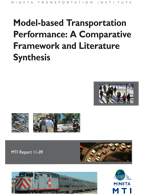- 408-924-7560
- mineta-institute@sjsu.edu
- Donate
Model-based Transportation Performance: A Comparative Framework and Literature Synthesis
In an era of limited resources and a proliferation of data, there is increasing pressure to conduct careful evaluations of the economic, environmental, and equity effects of investments and policies that influence transportation and land-use systems. This report compares performance measures recommended to achieve desired goals and reviews the literature to determine the degree to which these measures have been implemented and what they indicate about the relative effectiveness of land-use, transit, and automobile pricing policies. Despite the variation in methods and performance measures implemented in the studies reviewed for this report, the synthesis of study results suggests the direction and relative magnitude of change resulting from different types of policies, as well as potential biases introduced by omitting the representation of the land-use and transportation interaction. Overall, the performance measures indicate that carefully designed transit, land-use, and automobile pricing policies may improve travel, economic, environmental, and equity conditions for communities. However, transit and peak-period automobile pricing policies can, in some situations, lead to negative performance outcomes across some or all measures, as illustrated in studies that explicitly represent the land-use and transportation interaction.
CAROLINE RODIER, PhD
Dr. Caroline Rodier is Associate Director of the Urban Land Use and Transportation Center (ULTRANS) at the University of California, Davis. Her major areas of research include transportation and environmental planning and policy analysis. She has extensive experience applying land-use and transportation-demand models to evaluate the performance of a wide range of transportation and land-use policies. Recently, she has overseen the development of the California Travel Demand Model, which is the first activity-based travel-demand model developed on a statewide scale. Dr. Rodier also provided extensive research support to the California Air Resources Board in their development of the scoping plan for Assembly Bill 32, the Global Warming Solutions Act, including an international review of the modeling evidence on the effectiveness of land-use and transportation strategies
MARGOT SPILLER
Margot Spiller works as a junior specialist at ULTRANS. She received her B.Sc. from Massachusetts Institute of Technology and M.Sc. in transportation engineering and city planning from University of California, Berkeley. She currently works as a transportation engineer and planner. Her research interests include the land-use and transportation connection and emissions reductions from the transportation sector. This is her second co-authored report.
-
Contact Us
San José State University One Washington Square, San Jose, CA 95192 Phone: 408-924-7560 Email: mineta-institute@sjsu.edu






